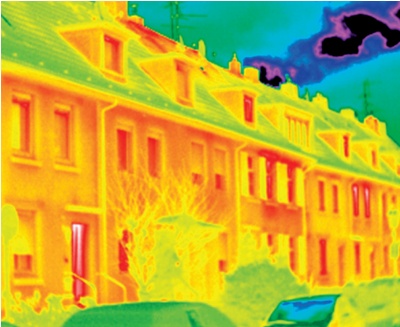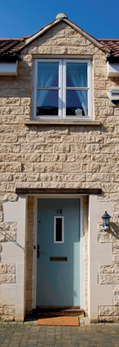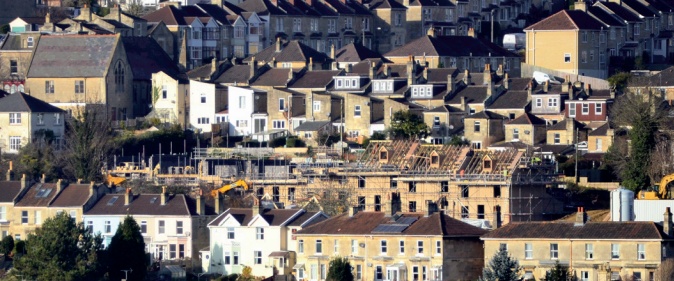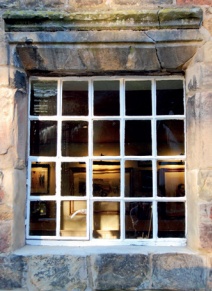Environmental Impacts
Restore or Replace?
Craig Jones
 |
| Thermographic image showing heat loss from traditionally constructed terraced houses (Photo: Mitifo, iStock.com; all other photos: Jonathan Taylor) |
As well as the 600,000 or so listed buildings, it is estimated that almost 6 million dwellings in the UK were built before 1919. There comes a time in the life of every building when extensive refurbishment is required, and for some developers this raises the question of whether it might be better to start again.
Many would argue that refurbishment cannot bring old buildings up to modern energy efficiency standards, and these days demolition and replacement is all too often the favoured option. Conservationists, who inevitably favour repair and refurbishment, counter this by pointing to the energy used to make new buildings.
But what does environmental analysis show? Does it support refurbishment, or replacement? When making the argument for conserving traditionally constructed buildings, conservationists need to be aware of the facts and avoid suppositions. This article explores the issues.
Traditional buildings were constructed with materials and details that conduct heat from the interior to the exterior. During refurbishment it is possible to introduce insulation into many elements, making substantial improvements to their energy use. However, some traditional details often prevent energy performance levels to equal those of modern construction. For example, the appearance of fine brick or stone may prevent the use of insulation on solid masonry walls externally, while a finely plastered interior may prevent insulation of the inside face, and the need for permeability and vapour movement can cause problems for insulation in any case. Ground floors and cross walls provide thermal bridges that also need to be addressed.
In addition to considering the energy used to heat a building, any analysis also needs to consider the ‘embodied carbon’ of building materials. This is the amount of carbon released during the production and processing of materials. It mainly comes from the consumption of fossil fuel energy throughout the production supply chain. Environmental analysis therefore considers consumption at all stages, such as material extraction, refining, transportation, processing, assembly and fabrication.
While it is true that many older buildings cannot be refurbished to the same energy standards as modern construction, the additional impact of new materials must be considered. Refurbishment requires fewer materials and therefore less embodied carbon. But is this enough of a carbon swing to sway the argument in favour of refurbishment?
To answer this question, embodied and operational carbon need to be considered side by side, which is called the whole-life carbon footprint. Let’s start by looking at embodied carbon. Embodied carbon is all too easily forgotten because it is largely concealed from view – most people are unaware of the high environmental impact associated with the production of the goods they consume.
 |
 |
|
| Left: Traditional details in new development rarely match the quality of historic architecture, no matter how good the materials. Right: Brynmor Terrace, Penmaenmawr, North Wales, badly damaged by aluminium double glazing and other home improvements. Double glazed timber windows have since been installed in some of the houses with the aid of grants from Conwy County Borough Council under a townscape heritage initiative. | ||
New-build houses in the UK (which are among the smallest in Europe) release on average around 45 tonnes CO2e (carbon dioxide equivalent) during construction. This is enough carbon to power a light bulb continuously for over 450 years, or to power a television for two hours a day for almost 1,440 years. It’s also enough carbon to drive to the moon. The embodied carbon levels are, of course, far higher for non-domestic buildings and larger domestic estates.
To place these figures into further perspective we need to compare them with the operational carbon of houses. Operational carbon varies widely but the average UK household emits in the region of 3,300 kg of CO2 to heat their home. This value includes space and hot water heating, but not the energy for lighting or appliances, which have their own embodied versus operational carbon balance. In contrast, the heating carbon of a new-build UK house is around 2,000 kg of CO2 per year. This means that rebuilding a new house saves about 1,300 kg of operational carbon every year. However, it comes at the expense of the additional embodied carbon emissions of the new construction.
To rebuild the house, 45,000 kg of carbon dioxide is required. It therefore takes 34 years before the savings in operational carbon have matched the extra embodied carbon that has been spent to rebuild the house. This is particularly significant, because if you include the time it takes to build the new house it will be around 2050 before the carbon starts to pay back. The UK has legally binding targets to reduce its carbon emissions by 80 per cent by 2050, from a 1990 baseline. Rebuilding the UK housing stock therefore doesn’t help to meet these targets. Instead we must look to refurbishment to help with this challenging target.
This, however, is where our generic embodied carbon analysis must stop. Each refurbishment is entirely different and therefore each case needs to be assessed individually. The embodied carbon of the materials for a refurbishment needs to be compared with the additional operational carbon saving for the building under study. Each building also has a different energy use profile. This should be done on a case-by-case basis. However, the analysis above still shows that refurbishment is a promising option and that refurbished buildingdo not necessarily need the same level of thermal performance to compete when considered from a whole-life carbon perspective.
There are, of course, many products that do not impact on the operational carbon of a building. The refurbishment of such materials and products typically brings with it a carbon benefit. Retaining existing materials avoids the need for new materials and products.
When it comes to refurbishment and repair, some simple measures can be taken to reduce the embodied carbon footprint. One of the most effective is to reuse materials, either on the same project or elsewhere. Reuse of materials can save up to 95 per cent of the embodied carbon emissions of buying a new product.
Beyond this, there are savings to be made through material selection. One rule of thumb is ‘timber first’. Timber is a natural material that has a wide range of uses and, if responsibly sourced, its production has a relatively low environmental impact. Therefore if timber materials and products are suitable it is usually a lower carbon option.
 |
|
| A new terrace of traditionally detailed houses rises on the outskirts of Bath. The city was inscribed as a World Heritage Site in 1987 and opportunities for both development and improvement are understandably limited. ‘Warmer Bath’, published by Bath Preservation Trust and the Centre for Sustainable Energy gives advice on energy efficiency improvements for traditional homes in the city (see Further Information). |
Timber from sustainably managed sources also stores carbon, which is a carbon footprint benefit. Timber is composed of approximately 50 per cent carbon by mass. What’s more, this carbon has been extracted from the atmosphere through photosynthesis. The carbon is stored in the timber and away from the atmosphere until the end of the life of the product. In fact, the carbon storage element of timber means that it is storing more carbon than was released to produce the timber product. This often results in a large carbon footprint benefit and partly explains why the timber first principle works well.
Another good saving is the use of waterbased instead of solvent-based paints. A water-based paint has a carbon footprint around a third lower than a solvent-based one. Paint has a high embodied carbon value and is typically applied in multiple coats. Therefore using fewer coats, where possible, is another good way of reducing its impact. Likewise, painting less often has a large benefit. Repainting a room or an object too often makes a considerable difference to its whole life carbon footprint.
Bricks and mortar are high-carbon items but have a long lifespan. The embodied carbon of these products therefore needs to be retained for as long as possible to gain maximum value from them. One way of doing this is to use a lime-based mortar, which has less embodied carbon than cement. At the end of the lime mortar’s lifespan the brickwork can also be dismantled and reused more easily than if a cement-based mortar had been used. This gives the bricks a second lifetime, offering significant embodied carbon savings.
 |
|
| Like many historic features, cast iron windows have inimitable character, but they do drain heat. Secondary glazing and insulated blinds offer the only practical solution. |
There are naturally some instances where embodied carbon doesn’t need to be considered. For example, the embodied carbon of additional insulation almost always pays back through operational carbon savings. Due to their composition and methods of production some types of insulation have lower embodied carbon but if this comes at the expense of a considerably poorer thermal performance, they are unlikely to be an attractive whole-life carbon choice.
So far refurbishment has come out well, but is it always best? Unfortunately not. There are cases where it is better to replace than to repair. For example, if single glazed windows are upgraded to double glazed units, the embodied carbon of the new windows will be paid back by the operational carbon savings and the occupants will experience enhanced thermal comfort.
For listed buildings where single glazed windows are common, this can be more difficult as the replacement will affect the significance of the building, and listed building consent will be required. There may be occasions where the original windows have been replaced in the past, justifying a further change.
In other cases it may be possible to introduce draught-stripping with secondary glazing and thermal blinds, as these measures can achieve a thermal performance equivalent to that of double-glazing. Alterations such as these offer compromises that we need to consider.
When it comes down to a choice between refurbishing or replacing, embodied carbon often becomes a useful ally. Arguments that point to the reduced thermal performance of refurbished buildings should be balanced by a careful consideration of the additional embodied carbon expense of the new build. While there are cases where rebuilding is the best option there are many more where refurbishment is the better choice. Furthermore, without refurbishment the UK would lose much of the charm and character of its older building stock.
Historic and traditional architecture contributes to our enjoyment of the places we live and work, and makes a significant contribution to the UK economy, particularly through tourism. Reducing the carbon foot print of the UK’s building stock is without doubt extremely important, but it is not the only criterion that needs to be taken into account when considering the future of our historic buildings.
Further Information
Inventory of Carbon & Energy Database, an embodied carbon database for materials, Circular Ecology, 2011
Domestic Energy Fact File, Department of Energy and Climate Change, 2012
W Anderson and J Robinson, Warmer Bath: A Guide to Improving the Energy Efficiency of Traditional Homes in the City of Bath, Centre for Sustainable Energy and Bath Preservation Trust, 2011



